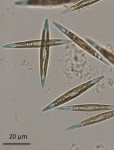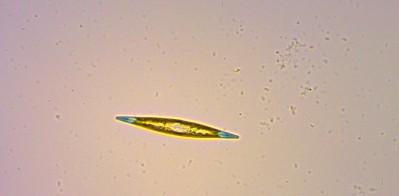
Among the diatoms, H. ostrearia has a peculiarity in producing a water-soluble blue pigment so-called marennine, derived from the Marennes-Oléron area. This diatom species has a fusiform siliceous frustule characterized by bilateral symmetry form as pennate, from the family of Bacillariophyceae.
Like many other diatoms, H. ostrearia undergoes the mitotic cell division. One of the daughter cells is identical in size to the parental cell, and the other is smaller, which leads to a reduction in the average cell size of the population and to its vanishment. This vegetative reproduction can be counteracted in the natural environment by a phase of sexual reproduction, triggered by short photoperiod at low irradiance conditions and sexual compatibility between pairs of clones. This phase occurs when zygotes turn into auxospores, which expand and form initial cells that recover the maximum specific cell size.

H. ostrearia (Simonsen 1974)
Division : Bacillariophyta
Class : Bacillariophyceae
Sub-class : Bacillariophycidae
Ordo : Naviculales
Sub-ordo : Naviculineae
Family : Naviculaceae
Genus : Haslea
Species : Haslea ostrearia
The genus Haslea is described as ubiquitous and H. ostrearia is considered as thychopelagic species as it exists in benthic, planktonic and occasionally in both epiphytic (associated with plants) and epilithic (associated with stone and other hard substrates), living in both warm and tropical waters.